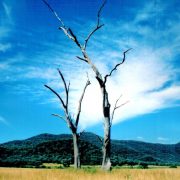Paddock trees in 40 years
 When we think of the ecosystem services provided by trees, we often picture large stands of forest. But scattered paddock trees are also an important part of the landscape and deliver multiple benefits on healthy and productive farms.
When we think of the ecosystem services provided by trees, we often picture large stands of forest. But scattered paddock trees are also an important part of the landscape and deliver multiple benefits on healthy and productive farms.
Paddock trees supply production benefits by providing shelter for stock and crops, habitat for pollinators as well as birds and bats beneficial for pest control, and improve soil structure and fertility as well as aiding in the management of salinity.
Scattered paddock trees also serve an important function for native wildlife, providing a food source and nesting sites. They also act as stepping stones for animal movement between other patches of vegetation and water sources.
Paddock trees on agricultural land in temperate Australia are in decline. This is not isolated to paddock trees, mature trees in larger stands of vegetation are also disappearing, but often the effects are more pronounced in isolated trees.
A lot of these trees are simply dying of old age; most of the existing mature trees are old and little regeneration is occurring.
However, factors such as insect damage, mistletoe infestation, wildfire, stubble and log litter burning, clearing and cultivation also contribute to dieback. Changes to soil fertility and water retention levels due to pasture improvement and the use of fertilizers and hebicides can also have an impact.
The extent and severity of tree decline has reached historically high levels in the past few decades and some estimates predict that in 40 years all the paddock trees could be gone.
But even these dead or dying trees have a role providing homes and shelter for wildlife, particularly mature trees with hollows which are scarce nesting sites for a number of species. The cracks and crevices in bark likewise provide habitat for invertebrates and small animals.
There are a number of things you can do to help protect paddock trees and help their regeneration on your patch.
Fencing around selected trees will help to protect them from stock and limit detrimental agricultural practices such as applying fertilizer in the root zone and reducing herbicide spray drift. Wire netting can also protect from ringbarking by stock and feral animals.
Planting additional shade trees for stock can also take the pressure off the old giants.
Installation of temporary fencing will help natural regeneration to take place; an area twice the size of the tree canopy is ideal. Managing grazing and pest herbivores such as rabbits, hares, goats and kangaroos will also give the young saplings the best chance of survival.
Logs, stumps, and fallen branches are also habitat for ground-dwelling animals and allowing timber to rot on the ground benefits soil fungi, which play an important role in nutrient cycling. So refrain from burning; leave timber where it is or relocate to a more convenient remnant vegetation area or creek as wildlife habitat.



